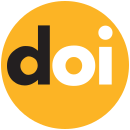 | |
| Full name | Digital object identifier |
|---|---|
| Acronym | DOI |
| Organisation | International DOI Foundation |
| Introduced | October 1997[1] |
| Example | 10.1000/182 |
| Website | www |
A digital object identifier (DOI) is a persistent identifier or handle used to uniquely identify various objects, standardized by the International Organization for Standardization (ISO).[2] DOIs are an implementation of the Handle System;[3][4] they also integrate with the URI system (Uniform Resource Identifier). They are widely used to identify academic, professional, and government information, such as journal articles, research reports, data sets, and official publications.
A DOI aims to resolve to its target, the information object to which the DOI refers. This is achieved by binding the DOI to metadata about the object, such as a URL where the object is located. Thus, by being actionable and interoperable, a DOI differs from ISBNs or ISRCs which are identifiers only. The DOI system uses the indecs Content Model to represent metadata.
The DOI for a document remains fixed over the lifetime of the document, whereas its location and other metadata may change. Referring to an online document by its DOI should provide a more stable link than directly using its URL. But if its URL changes, the publisher must update the metadata for the DOI to maintain the link to the URL.[5][6][7] It is the publisher's responsibility to update the DOI database. If they fail to do so, the DOI resolves to a dead link, leaving the DOI useless.[8]
The developer and administrator of the DOI system is the International DOI Foundation (IDF), which introduced it in 2000.[9] Organizations that meet the contractual obligations of the DOI system and are willing to pay to become a member of the system can assign DOIs.[10] The DOI system is implemented through a federation of registration agencies coordinated by the IDF.[11] By late April 2011 more than 50 million DOI names had been assigned by some 4,000 organizations,[12] and by April 2013 this number had grown to 85 million DOI names assigned through 9,500 organizations.[citation needed] Fake registries have even appeared.[13]
- ^ Morgan, Cliff (n.d.) [This article is an expanded and updated version of a presentation to the Wiley Library Advisory Board, 18 November 1997.]. "The DOI (Digital Object Identifier)". Serials. UKSG (formerly United Kingdom Serials Group). Archived from the original on 2 August 2007. Retrieved 30 September 2024.
- ^ "ISO 26324:2012(en), Information and documentation – Digital object identifier system". ISO. Archived from the original on 17 June 2016. Retrieved 20 April 2016.
- ^ "The Handle System". Handle.Net Registry. Archived from the original on 7 January 2023.
- ^ "Resources (including Factsheets)". DOI. Archived from the original on 25 December 2022.
- ^ Witten, Ian H.; Bainbridge, David & Nichols, David M. (2010). How to Build a Digital Library (2nd ed.). Morgan Kaufmann. pp. 352–253. ISBN 978-0-12-374857-7.
- ^ Langston, Marc; Tyler, James (2004). "Linking to Journal Articles in an Online Teaching Environment: The Persistent Link, DOI, and OpenURL". The Internet and Higher Education. 7 (1): 51–58. doi:10.1016/j.iheduc.2003.11.004.
- ^ "How the "Digital Object Identifier" Works". BusinessWeek. 23 July 2001. Archived from the original on 2 October 2010. Retrieved 20 April 2010.
Assuming the publishers do their job of maintaining the databases, these centralized references, unlike current web links, should never become outdated or broken
- ^ Liu, Jia (2021). "Digital Object Identifier (DOI) Under the Context of Research Data Librarianship". Journal of eScience Librarianship. 10 (2): Article e1180. doi:10.7191/jeslib.2021.1180.
- ^ Paskin, Norman (2010), "Digital Object Identifier (DOI) System", Encyclopedia of Library and Information Sciences (3rd ed.), Taylor and Francis, pp. 1586–1592
- ^ Davidson, Lloyd A.; Douglas, Kimberly (December 1998). "Digital Object Identifiers: Promise and problems for scholarly publishing". Journal of Electronic Publishing. 4 (2). doi:10.3998/3336451.0004.203.
- ^ "Welcome to the DOI System". doi.org. 28 June 2010. Archived from the original on 13 August 2010. Retrieved 7 August 2010.
- ^ "DOI News, April 2011: 1. DOI System exceeds 50 million assigned identifiers". doi.org. 20 April 2011. Archived from the original on 27 July 2011. Retrieved 3 July 2011.
- ^ "Important Alerts". www.doi.org.